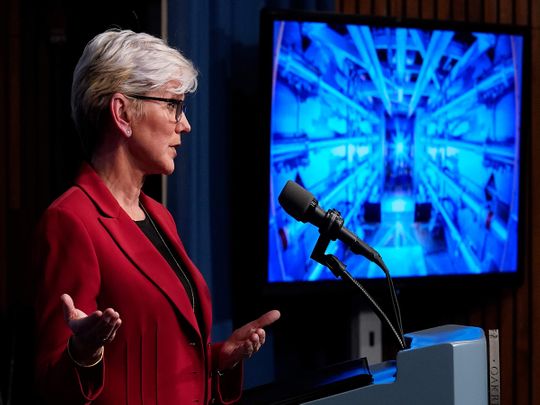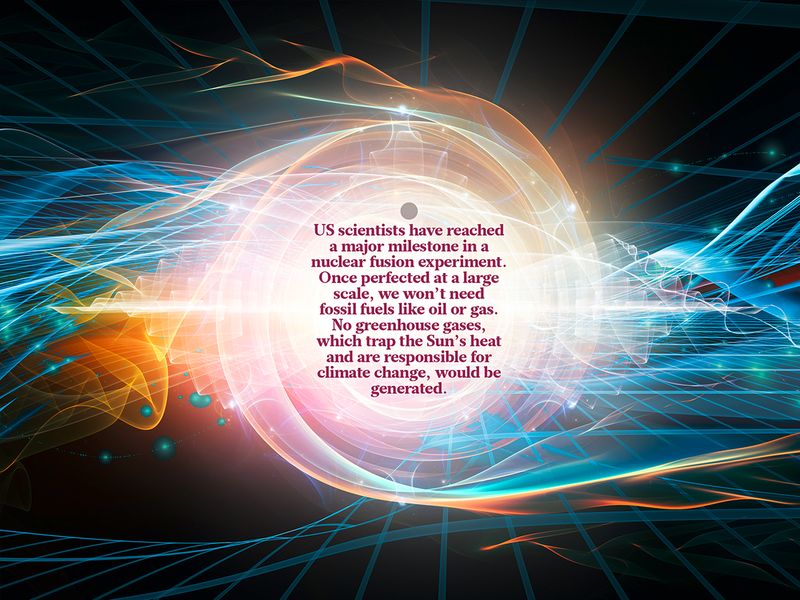
I know all the reasons we’re not supposed to freak out about the news that US scientists just reached a major breakthrough in nuclear fusion.
Sure, data suggests that for the first time, we have achieved “ignition” — a fusion reaction that propagates, producing more energy than it took to start the process.
While these scientists did reach ignition, getting there for even a trillionth of a second required an array of 192 lasers so huge that the building where they’re housed is 10 stories high and three football fields long. The lasers focused on a tiny fuel pellet composed of rare hydrogen isotopes. And the resulting reaction generated only about 20 per cent more energy than it absorbed.
It is a long way from the dream of nuclear power that is safe. Scientists have been chasing this dream since the 1950s, so long that it has become a mordant joke: “Fusion is the energy of the future … and always will be.”
For now, that old saw remains true; the reaction would have to generate hundreds or thousands of times more energy than went into it to begin to be an economical source of power. The hurdles to get there are enormous, possibly the most complicated engineering project humanity has ever undertaken.
So it’s probably premature for sing: “Clean, green energy for everyone!,” but … nope, actually, going to do the happy dance anyway. Scientists have accomplished a net energy gain from a fusion reaction. This is potentially the biggest news of the decade.
As you might already have heard, you are literally made of stardust. Most of the atoms in your body were forged in the core of some ancient sun, as lighter elements fused into heavier ones; you are the vicarious survivor of star fire and supernovas.
Now your species is making stars — very ephemeral but nonetheless we are inching toward mastering the very process that made our world. This shift from product to producer would be wondrous even if it didn’t hold out hope for an energy revolution as profound as the shift from horsepower to fossil fuels.

Transforming the society
I won’t try to sketch out how much steady, reliable, indefinitely renewable clean energy could transform society. I couldn’t possibly predict, any more than the 18th-century scholars fiddling with Leyden jars could have foretold ice cream cakes and social media influencers.
But the energy they ultimately unleashed — along with their fellow tinkerers on steam engines — made possible humanity’s greatest period of flourishing.
In the three centuries since Thomas Newcomen deployed his primitive steam engine at a Staffordshire mine, we went from a world where the average person lived at subsistence level and half of children died before reaching adulthood to one where most children survive to their 15th birthdays and end up on average healthier, better fed, more lavishly entertained and more comfortable than a medieval king.
Obviously, the journey from poverty to abundance was fuelled by many technological breakthroughs, but all of it — from drug development to fibre-optic lines to water treatment plants — was possible only because a new source of power delivered many times what human or animal muscle could manage.
As Andrew McAfee points out in his book “More From Less,” from 1800 to 1970, the United States’ gross domestic product and its energy consumption rose in near lockstep.
A massive breakthrough
They eventually decoupled, in part because the costs of burning hydrocarbons forced us to look for ways to economise. But what if we didn’t have to economise? What could humanity do for ourselves and our planet?
Solve our water problems with low-cost desalinisation? Scrub carbon and other pollutants from the air? Bring the whole world up to a Western standard of living — and beyond — without worrying about the environmental cost?
Whatever the answer is, it means easier, better lives, with more possibilities for human flourishing.
Yes, the results from Lawrence Livermore National Laboratory, California are some time away from a working fusion reactor. But this is how innovation works.
When Thomas Edison emerged from his laboratory with a working light bulb, it had been hundreds of years since the first scientific experiments with electricity, and it would be many more years before cities would blaze with electric light.
Human progress is the story of serial failures and halting, partial successes that add up, over centuries, to miracles. If Livermore’s results hold up, humanity will have taken a major step toward harnessing the power of the stars.
No matter how much longer the journey takes, we can marvel at its audacity, and at how far we’ve already come.
Washington Post
Megan McArdle is the author of “The Up Side of Down: Why Failing Well Is the Key to Success”









